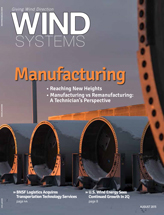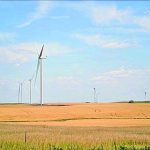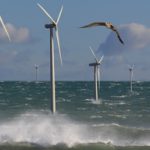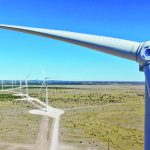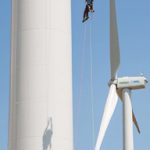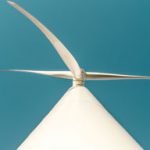The state of the American wind industry is strong, and with the right policies, we stand ready to double in the next five years and double again by 2030.
The U.S. wind industry added 23,000 jobs in 2014, boosting the sector’s total to 73,000 jobs. U.S. wind manufacturing alone now employs nearly 20,000 workers in more than 500 facilities across 43 states, in addition to 53,000 other jobs in project development, construction, operations, and other parts of the industry. The U.S. wind industry drove $12 billion in private investment last year, for a total of more than $100 billion since 2008.
HOT SPOTS
The U.S. “wind rush” is at its height in Texas, with 7,500 MW of wind projects currently under construction, more than all other states combined.
Underscoring the importance of sound policy, the Competitive Renewable Energy Zone transmission lines have played a critical role in opening up Texas’s world-class wind resources to development. That success can be replicated in other states if they approve of the major new transmission upgrades that have been proposed.
The Texas wind boom resulted in the addition of 9,000 jobs in 2014, bringing Texas to a U.S.-leading 17,000 wind industry jobs. Rounding out the top five states with the most wind industry jobs are Iowa and Colorado with over 6,000 jobs each, Oklahoma with nearly 5,000, and Michigan with over 3,000.
U.S. LEADS WORLD IN WIND ENERGY PRODUCTION
Thanks to performance-based incentives like the federal Production Tax Credit (PTC) — wind’s primary policy driver — and a world-class wind resource, the U.S. leads the world in wind energy production. There is now enough wind installed in the U.S. to power 18 million homes.
In 2014, Iowa led the nation for percentage of electricity from wind, at 28.5 percent, followed by South Dakota at 25.3 percent and Kansas at 21.7 percent. Wind energy provided more than 15 percent of the total electricity generated in seven states, and more than 10 percent in a total of nine states.
It was also the primary choice for new generating capacity in the wind-rich Midwest, Pacific Northwest, and Plains regions, providing 60 percent or more of all new electric generation capacity in those areas between 2011 and 2014.
AFFORDABILITY AND PRICE STABILITY
Wind energy is attractive to energy purchasers because of its affordability and price stability it is both affordable and stably-priced. The cost of wind has dropped 58 percent in just five years, according to the most recent study by Wall Street financial advisory firm Lazard. Energy purchasers are also attracted by wind energy’s locked-in prices and unique lack of fuel cost, allowing it to provide utilities and other purchasers with a more balanced energy portfolio that protects against increases in the price of fuels.
In 2013-2014, a record 11,000 MW of long-term wind power purchase agreements (PPAs) were signed. These are contracts under which wind project owners provide their output to another party—traditionally, utilities—which then provide the energy to their customers.
But utilities aren’t the only companies entering wind PPAs and buying wind power. At least 60 non-utility entities have made long-term wind energy purchases, including Microsoft, Dow Chemical, Google, Ikea, Walmart, and other household names. Over 23 percent of the wind capacity contracted through 2014 power purchase agreements was with non-utility purchasers, including companies, but also universities, government agencies, and other organizations.
“Our ability to lock-in wind power’s competitive prices over the long-term allows us to hedge against rising prices for other fuels, saving us money,” said Brian Janous, Director of Energy Strategy for Microsoft. “Wind power benefits our bottom-line while also meeting our desire to positively impact the environment.”
BENEFITS THAT FIT TODAY’S NEEDS
Wind energy production avoided the equivalent annual emissions of 26 million cars in 2014. This benefit is drawing the attention of many states and utilities that are seeking a low-cost way to comply with the U.S. Environmental Protection Agency’s (EPA) proposal, known as the Clean Power Plan, to reduce carbon pollution from existing power plants. Wind can be the biggest solution nationwide, and save consumers money doing it by avoiding fuel price risk and continuing to drive down costs.
Wind energy also avoided the consumption of nearly 70 billion gallons of water in the U.S. in 2014, the equivalent of conserving roughly 219 gallons per person in the U.S. This is an increasingly valuable benefit as severe drought continues to affect many of America’s primary wind-producing regions. For example, in drought-ravaged California, wind energy saved 3.4 billion gallons of freshwater in 2014, while Texas led the nation with savings of over 13 billion gallons of water.
MORE TO COME
The U.S. wind energy industry has barely begun making the economic and energy impact of which it’s capable. The U.S. Department of Energy’s (DOE) landmark “Wind Vision” report released this year shows that wind energy can double within the next five years to supply 10 percent of U.S. electricity by 2020, double again to 20 percent by 2030, and reach 35 percent by 2050. DOE also made headlines in May, when it released a report showing that ever-advancing wind turbine technology could eventually bring wind energy development to every state in America.
The Southeast, for example, already benefits economically from a strong wind turbine supply chain; wind project development would bring further economic development to the region, including well-paying construction and operations jobs. The ability to use in-region wind can provide Southeastern states and utilities with additional low-cost options for compliance with EPA’s Clean Power Plan.
ADVANCING POLICY TO BENEFIT AMERICA
Policy drives the energy sector, with virtually all U.S. technologies receiving policy support of some kind. Wind energy’s rapid advance in the U.S. is impressive when considering the unstable policy environment in which it has been forced to operate. The PTC has operated under short-term extensions of usually one and two years, and Congress has allowed the PTC, which provides up-front tax relief of 2.3 cents per kilowatt-hour for the first 10 years of a project, to expire several times in recent history.
The wind industry is working to ensure that this pattern of inconsistent policy ends now, and that the PTC is extended for as long as possible. With stable policy, the industry can realize the DOE’s Wind Vision and emerge as the biggest, fastest, cheapest way for states to meet EPA’s Clean Power Plan.
















